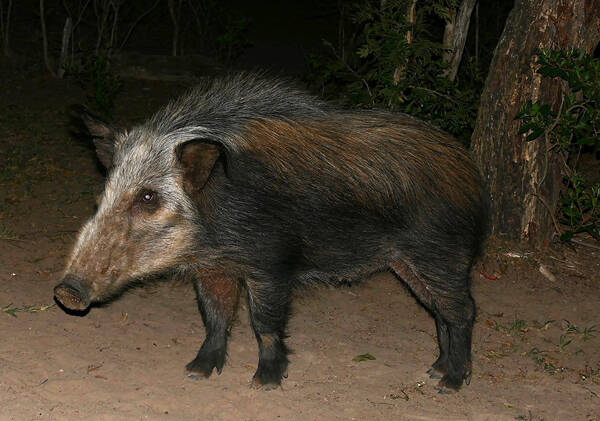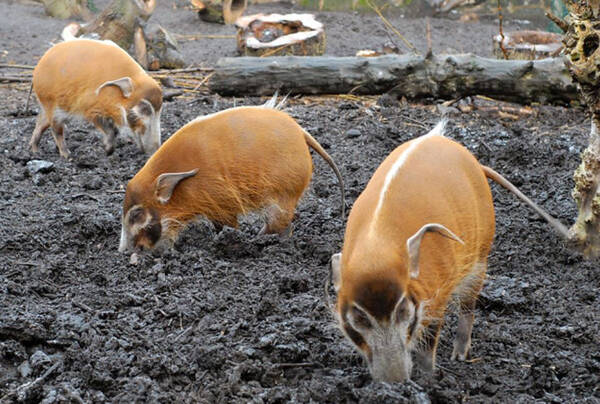Potamochoerus larvatus
IUCN
LCBasic Information
Scientific classification
- name:Potamochoerus larvatus
- Scientific Name:Potamochoerus larvatus,Bushpig,Jungle Pig
- Outline:Ungulata
- Family:Artiodactyla Suidae A.peccary
Vital signs
- length:100-150cm
- Weight:54-115kg
- lifetime:About 20 years
Feature
The male has warts on his nose and a long tail with a tuft of coarse hair at the tip.
Distribution and Habitat
Origin: Angola, Botswana, Burundi, Democratic Republic of Congo, Eswatini, Ethiopia, Kenya, Malawi, Mozambique, Namibia (Caprivi Strip), Rwanda, Somalia, South Africa, Sudan, Tanzania, United Republic, Uganda, Zambia and Zimbabwe.
Introduced: Comoros, Madagascar and Mayotte.
Inhabits a variety of habitats from sea level to montane forests, including coastal forests, flooded forests, swamps, woodlands, and mixed scrub and cultivated land. The habitat of this species is related to relatively dense vegetation types with available food, cover and water, forests and rivers or dry scrub and jungle layers. The species lives at different altitudes. In East and Northeast Africa, it inhabits the Ethiopian Highlands (Harenna Forest), the highlands of the Albertine Rift Valley, and up to 4,000 meters on Mount Kilimanjaro. They can also adapt to human-impacted habitats, as they eat agricultural food crops, and are also found in areas with subsistence farming or agricultural crops such as suga
Appearance
The peccary is 100-150 cm long, 55-80 cm tall at the shoulder, 30-43 cm long tail, and weighs 54-115 kg. It is stocky in appearance, with a barrel-shaped body and relatively short legs. Males have a bony crest and warts on their snouts. The tusks, or canines, point upward and outward. The upper tusks are small and barely visible. The lower tusks are prominent and very sharp, up to 7 cm long.
The fur is shaggy, ranging from light reddish brown to grayish brown to almost black, mostly black, becoming darker with age. The head area is usually a different color from the rest of the body, with the upper part of the face and ears also being lighter in color. There is a long, erected line of hair along the spine that forms a mane, starting between the ears and extending to the back. Both sexes have this light-colored mane, with males usually larger than females, and the mane becomes darker when they are agitated. The tips of the ears have a moderate amount of hair, although not as long as
Details
Masked wild boar (scientific name: Potamochoerus larvatus) is also known as Bushpig in English. There are 6 subspecies.

Masked wild boar is a resident animal and vigorously protects its territory. It is mainly active at night. This behavior is related to the ambient temperature, with more diurnal activity in the colder months. Resting in dense vegetation is common, and nesting may occur during the rainy season or cold periods. In addition, wallowing is a favorite activity. Interestingly, fruit-eating monkeys are often followed in the bushes to pick up fallen fruits for feeding. They are notorious for feeding on crops. Daily movement distances vary from 0.5-5 km.

The peccary is widespread and abundant throughout much of its range. This wild boar is highly adaptable and has been introduced to Madagascar and the Comoros Islands, where it is also thriving. In the Democratic Republic of Congo and Malawi, the species is thought to cause more damage to agriculture than any other species. Additionally, members of the genus are considered vectors of livestock diseases and may be hosts or vectors of tick-borne diseases such as trichinosis, African swine fever, and trypanosomes. As a result, they are widely persecuted by farmers and targeted by wildlife control programs. Main natural enemies: humans, leopards, lions, spotted hyenas, and pythons.
The masked peccary is not considered threatened throughout most of its known range. In fact, according to the World Conservation Union (IUCN), there is evidence that conversion of former forests to secondary shrubs and agriculture has led to an increase in its numbers in some areas. Attempts to control or eradicate the masked peccary in these areas have generally proven unsuccessful.
Listed on the IUCN Red List of Threatened Species (IUCN) 2015 ver 3.1 - Least Concern (LC).
Protect wild animals and stop eating game.
Maintaining ecological balance is everyone's responsibility!








